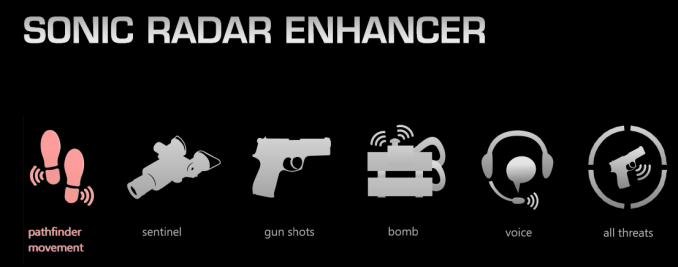ASUS ROG Press Conference: Sonic Radar Gaming Software
by Ian Cutress on June 3, 2013 11:53 PM EST- Posted in
- Trade Shows
- Software
- Asus
- ROG
- Computex 2013

With a brand focused at gamers (and overclocking), software is all important. Over previous generations ASUS have included better audio software packages, integrated SSD caching, network-stack bypassing NICs and options to improve ping – the next iteration of this is Sonic Radar.
The premise behind Sonic Radar is simple – an additional HUD image on the screen that shows the direction that sound is coming from. When dealing with games that output a 5.1 audio stream, the effect of each speaker in that audio stream is calculated and output as sound. We first had headphones that attempted to place the technology into the ears of the gamer, and now ASUS are transferring the details of that screen onto an image.

ASUS hope this will become another arsenal for a gamer to be the best. I obviously had questions regarding legitimacy – either eSports will disallow it or others may see it as cheating. On the first point, ASUS is not too concerned about the capability in eSports – it will either be allowed or not, but the bigger market is at-home gamers rather than those competing on a stage. The second point was addressed with an analogy – does the gamer with the faster GPU and higher resolution screen and better frame rate a cheater based on that advantage? It comes down to swings and roundabouts – if used against the gamer they may be unhappy, but they may enjoy it when they can use it. I could imagine this sort of thing being on a heads-up display for real soldiers, if it is not already.
Sonic Radar is set to be available soon with all ROG sound cards and 2013 motherboards with SupremeFX, initially as a download but will find its way onto the driver CD.











12 Comments
View All Comments
Eggrenade - Tuesday, June 4, 2013 - link
I think they should market this to deaf gamers. It probably wouldn't be too hard to add a HUD pop-up for game-state audio queues as well.Granseth - Tuesday, June 4, 2013 - link
Maybe Google could make something similar for Google glasses so deaf people could have a sonic radar in real life as wellhaukionkannel - Tuesday, June 4, 2013 - link
Actually that is very good idea! Like we now have cars with infrared cameras for dark time driving.nathanddrews - Tuesday, June 4, 2013 - link
Deaf people aren't the problem. We need sonic radar for non-deaf people! LOLI think distracted pedestrian deaths and injuries have gone up something like 20% over the last five years as smartphones and tablets have become so widespread.
I think this would be a great technology for deaf gamers and gamers that like to play quietly while listening to music or podcasts. It's not that far of a leap from games that feature floating names above characters, visual cues as to who is talking, or subtitles that describe gameplay events. I like it.
SetiroN - Tuesday, June 4, 2013 - link
LOL. That's going to be blocked by any anticheat system even without specific support.HOSH - Tuesday, June 4, 2013 - link
Agreed, PB and GSCC will probably block this along with the fact that server admins can actually block the use of Macros and applications like these.HisDivineOrder - Tuesday, June 4, 2013 - link
So instead of updating the current Phoebus drivers to something not beta or their sound cards to drivers that don't require everyone to go open source to find reasonable drivers, they're hard at work on Sonic Radar. Good to know Asus has prioritized well.Stop the gimmicks and focus on the core requirement: good drivers.
yougotkicked - Tuesday, June 4, 2013 - link
strikes me as mostly unnecessary, humans are pretty good at determining the direction sound comes from, I can't imagine a visual representation will help all that much.It DOES seem like a good idea for deaf gamers, or those who play with the audio turned down, it's just restoring some environmental info that's been lost.
erikiksaz - Tuesday, June 4, 2013 - link
Humans are pretty good at determining the direction of sound...in real life.But, we're talking about video games here. These are programmed, directional sounds. Our ears can only hear as well as the processes that serve them. In games it's not perfect, which is what they're trying to improve.
yougotkicked - Tuesday, June 4, 2013 - link
you have a point, though I would suspect that there's more to be gained by better sound work in games then by creating a graphical sonar, especially as the sonar uses the same information being fed to the speakers.